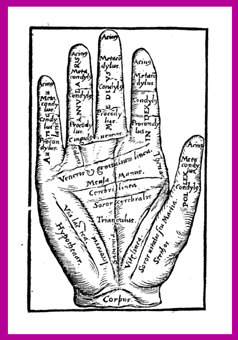Chiromancy and Girolamo Cardano

anonymous woodcut of chiromantic hand
from Girolamo Cardano,
De rerum varietate libri XVII (Basel, 1557)

 This
mixture of anatomical and chiromantic terminology is characteristic of
its author. Girolamo Cardano was a brilliant and flamboyant character,
his life a melodrama of poor health, a troubled career, and family disasters,
all compounded by political and religious instability. Analytical, eccentric,
and supremely sure of himself, Cardano, at the end of his life, wrote a
bizarre but still entertaining autobiography. Contemporaries admired
his achievements in mathematics, medicine, and natural philosophy, all
of them blended with astrology, natural magic, and divination. In 1560
the Inquisition accused Cardano of heresy; casting Christ's horoscope was
especially imprudent. Cardano wrote more than two hundred works. The book
in which the chiromantic diagram appears is a supplement to the first of
two encyclopedic projects, De subtilitate libri XXI, published in
1550. Both his encyclopedias enjoyed great contemporary popularity and
range widely in subject matter, including cosmology, mechanics, the natural
sciences, technology, cryptology, and the occult sciences. Cardano's extensive
treatment of chiromancy in chapter 79 of the De rerum varietate
begins with an enumeration of the parts of the hand, viewed as an instrument
of the body and a book of the soul (p. 557). He discusses the influences
of the planets, as well as the numbers, names, and significance of marks
on the hand, its lines, spots, colors, and creases. His autobiography tells
us that he saw his own destiny in the lines of his own hand, yet the same
work distances him from the form of divination that became riskier
as the century wore on.
This
mixture of anatomical and chiromantic terminology is characteristic of
its author. Girolamo Cardano was a brilliant and flamboyant character,
his life a melodrama of poor health, a troubled career, and family disasters,
all compounded by political and religious instability. Analytical, eccentric,
and supremely sure of himself, Cardano, at the end of his life, wrote a
bizarre but still entertaining autobiography. Contemporaries admired
his achievements in mathematics, medicine, and natural philosophy, all
of them blended with astrology, natural magic, and divination. In 1560
the Inquisition accused Cardano of heresy; casting Christ's horoscope was
especially imprudent. Cardano wrote more than two hundred works. The book
in which the chiromantic diagram appears is a supplement to the first of
two encyclopedic projects, De subtilitate libri XXI, published in
1550. Both his encyclopedias enjoyed great contemporary popularity and
range widely in subject matter, including cosmology, mechanics, the natural
sciences, technology, cryptology, and the occult sciences. Cardano's extensive
treatment of chiromancy in chapter 79 of the De rerum varietate
begins with an enumeration of the parts of the hand, viewed as an instrument
of the body and a book of the soul (p. 557). He discusses the influences
of the planets, as well as the numbers, names, and significance of marks
on the hand, its lines, spots, colors, and creases. His autobiography tells
us that he saw his own destiny in the lines of his own hand, yet the same
work distances him from the form of divination that became riskier
as the century wore on.
The above is slightly adapted from a catalogue entry by Brian P. Copenhaver and Claire Richter Sherman, in Claire Richter Sherman, Writing on Hands: Memory and Knowledge in Early Modern Europe (University of Washington Press for The Trout Gallery at Dickinson College, 2000).

 Nancy
G. Siraisi, The Clock and the Mirror: Girolamo Cardano and Renaissance
Medicine (Princeton: Princeton University Press, 1997)
Nancy
G. Siraisi, The Clock and the Mirror: Girolamo Cardano and Renaissance
Medicine (Princeton: Princeton University Press, 1997)
Anthony Grafton, Cardano's Cosmos: The Worlds and Works of a Renaissance Astrologer (Cambridge, Mass.: Harvard University Press, 2000).
Girolamo Cardano, The Book of My Life (De vita propria liber), trans. Jean Stoner (New York: E. P. Dutton, 1930).